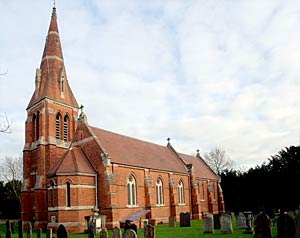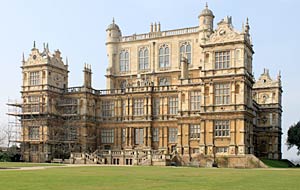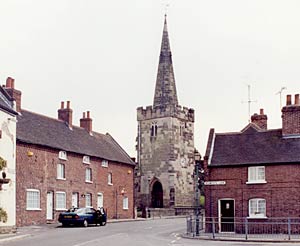< Previous | Contents | Next >
The Fleet Dives Underground

Church of All Saints, Winthorpe in 2009. © Copyright Tim Heaton and licensed for reuse under this Creative Commons Licence.
WINTHORPE. It seems like another world as the prosaic road from Newark brings us into its leafy glade and to its delightful houses and gardens, spacious roads, and gracious trees. By the inn at the side of the green the little River Fleet dives underground (as London's Fleet does) to come out smiling by the old village cross, and join a tiny willow-bordered brook as it rushes on.
It lies between the Fosse Way and the Trent, to which the fine grounds of the hall go down. During the dry summers late in the 18th century, foundations of a great bridge, believed to be Roman, were exposed in the river near by. The village came into story in the Civil War as one of a chain held by Parliament during the last siege of Newark.
Built half a century ago on an older site, the lofty church of brick and stone is attractive with many arches, and a tower and spire 105 feet high. An elaborately carved stone reredos has figures in niches.
The Great House and the Wonderful Book
WOLLATON. It has come into Nottingham with all its splendour, but a new road leaves the heart of the village secluded down a shady lane. The old pump stands in its shelter in the square, and here, too, is the inn with foundation stones said to be part of the home of the Willoughbys, as is the stone cottage facing the church where some of them lie, the spire rising from the treetops. For 600 years the story of the Willoughbys has been the story of the village, beginning when one of them married an heiress of the Morteins and ending but a few years ago. Some of them have helped to make the history of their county, and their country, and some of even a wider field; one of them built here as fine a house as any of his time. Sir Richard was Lord Chief Justice in the 14th century. Sir Hugh was the famous navigator who set out to discover the North-West Passage, and perished with his company off the coast of Lapland. Sir Francis of 1672 was a famous naturalist whose son became Baron Middleton.

Wollaton Hall in 2010.
It was another Sir Francis who built Wollaton Hall in the time of Elizabeth, a splendid house with features of the Gothic, Tudor, and classic styles. Dutch gables and pinnacles crown its four corner towers, a fine Prospect Room looks out from the central block, and the Great Hall inside has a handsomely carved stone screen and a fine hammerbeam roof. We can well believe, looking at the towers and turrets, domes and parapets, that it has a window for every day of the year, for it seems to be covered with them. It took eight years to build, and cost Sir Francis £80,000, in addition to the cost of the Ancaster stone, which was defrayed by Wollaton coal. It is believed that John Thorpe was its architect, and that Robert Smythson (who sleeps in the church) carried out the work with the help of craftsmen from Italy.
The park, with nearly 800 acres, has long been the glory of Wollaton. It has noble trees in plantations and groves, lovely gardens, and deer browsing by the lake in a woodland hollow. The fine 17th century brick wall enclosing the park was given its last length when the village of Sutton Passeys disappeared in the next century.
We may all see this fine place today, for in 1924 Lord Middleton sold the estate to Nottingham, and the house is now the home of the city's Natural History Museum. The builder has been at work in the park and the five-mile wall has been disturbed. The gardens are still fine, and there is a lovely cedar grove near a splendid flight of steps, with a peep of the golf links beyond. Unforgettable is the sight of the marvellous camelias in a house which cost £10,000 to build. Yet Wollaton holds nothing finer than the magnificent lime-grove, three-quarters of a mile long, which leads from the great stone gateway to the hall; and nothing more entrancing than the panorama from the leaded roof of the Prospect Room, with a view of Belvoir Castle 20 miles away.

Wollaton church (2002).
In the trim churchyard joining the garden of the white-walled rectory stands the church, much restored last century, when it was given a south aisle and a chapel to serve as the family pew. The three eastern bays of the north arcade are 14th century, the time of most of the old work. Two sides of the tower stand on open arches, through which we can walk outside the church.
Among the Willoughby memorials are the fine brass portraits of Richard of 1471 and his wife, he in plate armour and she in long cloak and gown. They lie on a tomb in a canopied recess, and below them lies a stone corpse. On a tomb between the chancel and the chapel lies Sir Henry Willoughby of 1528, with small figures of four wives beside him, and a stone corpse below. Three sons and three daughters are on the tomb, and it is thought that the third son may be Hugh, who was one day to be found frozen to death in his chair, with his will and his ship's log beside him.
On the death of Sir Francis, who built the hall, Wollaton passed to his daughter Bridget, who married her cousin, Percy Willoughby. Their memorial is a stone on the chancel wall, with a Latin inscription in beautiful raised lettering.
A priceless treasure, a rare gem for this village church, is the book of service and song which was used here for nearly a hundred years before the Reformation. Its great pages, about 22 inches by 15, are worn at the edges, but their rich illumination is almost as fresh as when they left the artist's hands 500 years ago. When Edward the Sixth's Prayer Book came into use this book was taken to the Hall and remained in the keeping of the family till Lord Middleton gave it back to the church in 1925. Here it lies in a glass case, the pages being turned over now and then. We saw it at Christmas, when the open page showed a charming picture of the Nativity, with the ox and the ass, a woman holding up the Child to Mary lying in bed, and Joseph sitting by. We saw it again at Easter, opened to show Our Lord stepping out of the Tomb. The book is almost complete. It was written and illuminated before 1460, for it belonged then to a rector of Wollaton whose executors bought it for ten marks and gave it for use in this church for ever.
The window pictures are a pleasing part of the church, two in the chancel being the work of Christopher Whall. One shows St Francis surrounded by a company of 30 English and foreign birds, with the chaffinch, robin, thrush, blue tits, sparrows, love-birds and doves among them, and St Nicholas with two children, one with a doll. It is in memory of a rector who loved birds and children, and who served here for 46 years. The chapel was restored in his memory, and has been given an oil painting for a reredos, showing in soft colours the scene in the Upper Room at Emmaus. The other Whall window is to James Cosmo Russell, who won the DSO and fell at Ypres in 1917; the window has figures of St George in gold and St Michael in silver, each standing on a dragon.
Heroes Frozen on Their Ships
SIR HUGH WILLOUGHBY, born early in the 16th century, won distinction and was knighted as a soldier. His military career ending with the fall of his patron Somerset, he turned from the land to the sea.
Sebastian Cabot having discovered North America when seeking the North-West Passage, Willoughby was made admiral of three little ships to seek an Eastern way to Asia along the north of Europe. With Richard Chancellor as pilot-general he sailed in May 1553, but the vessels were driven apart by a storm. Chancellor fouhd his way into the White Sea, made a sledge journey to Moscow, and laid plans for the foundation of our foreign commerce. Willoughby, recovering his second ship, sailed with it to Nova Zembla, the first Englishman to penetrate so far into the Arctic. Turning south, he reached the wild and inhospitable coast where Lapland joins Russia, with neither food nor clothing for an Arctic winter, the severity of which was not then understood.
Nothing was heard of them for about two years, but we know from Willoughby's diary that they spent some months at the end of 1553 in sending out three men south-south-west to see if they could find people, three others westward, and three south-east, all of whom came back after their long journeyings without finding any people or any sign of habitation. The last entry in Willoughby's journal is in October, and it tells us that "thus remaining in this haven the space of a week, and seeing the year far spent, and also very evil weather (frost, snow, hail as though it had been the deep of winter) we thought best to winter there."
Still nothing was heard of them, and the year 1554 passed with no news. Then in the spring of 1555 some Russian fishermen found Willoughby's two ships (Bona Esperanza and Bona Confidentia) on the icy coast, as silent as the grave, and on them were their crews, six merchants, two surgeons, Sir Hugh Willoughby, and in all about seventy men, frozen to death. With Willoughby were his diary and his will, the signature of the will making it clear that he was alive in January 1554.
There have been few more tragic spectacles than that upon which these Russian fishermen looked; we think of Scott and his comrades found in their tents half a world away down south as we picture these ships with their frozen crews in the great White North:
He with his hapless crew,
Each full exerted at their several tasks,
Froze into statues; to the cordage glued
The sailor, and the pilot to the helm.
